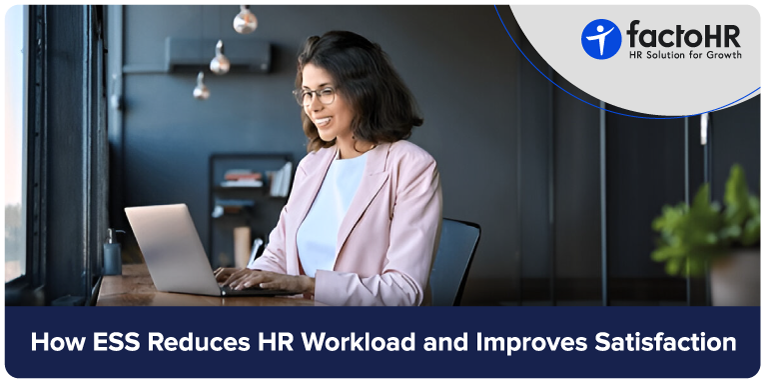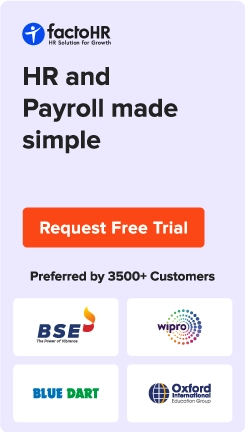How ESS Reduces HR Workload and Improves Satisfaction

Table of Contents
HR teams have many responsibilities, including organizing training, managing payroll, ensuring compliance, and facilitating smooth operations. All these tasks are exhausting when performed manually.
Handling employee data manually, including leave and attendance records, can be tedious and may lead to delays when errors occur. Instead, consider using the Employee Self-Service (ESS) portal, which allows employees to effectively manage essential human resources tasks, such as compensation, attendance monitoring, and leave management. Ess reduces HR workload by streamlining operations, reducing errors, and backlogs.
ESS fosters a culture of transparency and eases HR professionals’ tasks by simplifying HR processes and creating efficient workflows. It enhances HR processes, whether your organization operates remotely, in a hybrid model, on-site, or across multiple locations.
To implement ESS, you should know its advantages, challenges, and considerations, and how to choose the right ESS for your organization. This blog will discuss the benefits and challenges of ESS, as well as how to select the right one for your organization.

8 Ways ESS Reduces HR Workload and Improves Satisfaction
The digital transformation of workplaces increases the importance of ESS by providing employees with real-time access to their personal information and basic administrative tasks. It eliminates manual paperwork, reducing the reliance on HR teams so that they can focus on other strategic tasks, such as employee engagement and retention.
You can use these eight ways to gain the advantages of ESS in HRMS, reducing workload, and improving employee satisfaction. These include:
- Automating Routine Requests
- Minimizing Manual Follow-Ups
- Streamlining Approvals with Workflow Automation
- Faster access to HR Services
- Transparency in Personal and Policy Information
- Reduced Errors and improved Trust
- Supporting Data-Driven Decision Making
- Reducing Wait Times for Basic HR Needs

Automating Routine Requests
One of the most compelling reasons to embrace employee self-service (ESS) is to boost HR efficiency. Automating routine requests, such as updating employees’ personal information, payroll queries, and leave requests, minimizes human error and improves HR workflows.
Minimizing Manual Follow-Ups
Employee self-service (ESS) reduces HR workload by streamlining communication using a single centralized interface. It empowers employees with access to pay slips, tax forms, personal information, automated leave requests and approvals, as well as real-time status tracking. This ensures transparency and minimizes their need for manual follow-ups with the HR team.
Streamlining Approvals with Workflow Automation
Streamlining approvals with workflow automation in an ESS reduces delays, improves transparency, and boosts the efficiency of HR processes. Automating the approval process allows employees to submit requests and track their status in real-time, while managers can easily approve or reject requests.
Faster Access to HR Services
The ESS portal serves as a single point of contact, allowing employees to raise queries and HR administrators to provide solutions, thereby enabling employees to access HR services more efficiently. Employees can access the ESS portal on desktop or mobile devices to mark real-time attendance, leave application and approval, track or view leave balance, etc.
Transparency in Personal and Policy Information
The employee self-service portal allows workers to access their personal information, which includes company policies, pay slips, benefits management, and performance evaluations. This enhances transparency and fosters trust within the organization.
Reduced Errors and Improved Trust
Adding, updating, or maintaining employee data manually can lead to inaccurate data, missing updates, and payroll discrepancies. Allowing employees to revise their information in the self-service portal minimizes errors and enhances the trust between an organization and its workforce.
Supporting Data-Driven Decision Making
Employee self-service platforms often include analytics and real-time reporting features. HR professionals can compile a report using these insights, enabling data-driven decisions to enhance workforce optimization management.
Reducing Wait Times for Basic HR Needs
Self-service platforms provide an interface that allows users to directly raise queries, update employee information, request time off, and more, thereby reducing the unnecessary waiting period for approval or resolution from the HR department.

What are the Challenges and Considerations when Implementing an Employee Self-Service System?
Several challenges and factors must be addressed when implementing an employee self-service (ESS) portal. These challenges include integrating existing systems, ensuring user adoption, maintaining data security, and overcoming resistance to change.
Additionally, ensuring the portal adheres to data privacy laws is essential for the success of self-service portals.
- Engage with employees: Engage with employees to ensure they understand the purpose and benefits of the self-service software. Clear communication with employees and HR teams is essential for avoiding resistance to new systems.
- Training: Provide comprehensive training to employees to familiarize them with the self-service portal.
- Data security: To prevent data breaches, robust protection is needed.
- System Downtime: Frequent system downtime can disrupt an organization’s operations.
- Data Migration: Migrating employees’ data from manual to modern systems can be a challenging process.
The solution to these challenges is to focus on user-friendly platforms, partner with reliable vendors who provide unwavering support, plan for phased migration and testing, ensure data security, and encourage transparency about the benefits of using ESS.
How to Choose the Right Employee Self-Service?
With so many available options, choosing the right employee self-service portal with features that support your organization’s goals is essential. To make an informed decision, consider the following factors:
Intuitive interface: Choose an intuitive interface that your employees enjoy to encourage adoption and reduce frustration, leading to higher employee engagement.
Integration capabilities: Seamless integration with the HR software is essential for a smooth workflow. Select a self-service system that easily integrates with your existing HR software.
Mobile Compatibility: A portal that is compatible with smartphones increases convenience and efficiency, as field and remote employees can perform essential tasks more easily.
Security and Compliance: Select a platform with robust security features, including secure login, data encryption, and adherence to data privacy regulations, to ensure that sensitive information remains confidential.
Scalability: Ensure the self-service platform you choose scales with the organization’s evolving needs.
Support: A responsible customer support can help resolve your issues.

Conclusion
For modern organizations, self-service HR software is indispensable. ESS reduces HR workload by providing a single interface for employee-HR communication, improving efficiency, and empowering employees with direct access to essential information, which promotes organizational transparency.
However, to ensure a successful transition to employee self-service (ESS) systems, it’s essential to carefully consider the challenges of integration, user adoption, and data security. Choosing a suitable ESS reduces your HR’s workload, factoHR’s self-service portal redefines the employee experience by maintaining accurate data and increasing engagement.
If you’re interested in trying ESS but have some questions, schedule a demo today!
Grow your business with factoHR today
Focus on the significant decision-making tasks, transfer all your common repetitive HR tasks to factoHR and see the things falling into their place.

© 2025 Copyright factoHR


